Tench can be caught on a variety of fishing methods and rigs, but there are a few that really stick out. Especially when it comes to big tench, using these rigs, and using them the right way, can increase your chances of landing more fish significantly.
I have been fishing for tench for almost 20 years now and have managed to really fine-tune my techniques and end tackle. And trust me, it took me quite a while. Tench aren’t the easiest of coarse fish and can at times be extremely difficult to catch.
So in order to help you catch more and bigger tench, I decided to write this helpful article on the 5 best tench fishing rigs.
They include the most effective bottom rigs, as well as the very best float fishing rig and all of them have caught me plenty of really big tench over the years.
However, their efficiency does by no means imply that they are difficult to set up or fish! On the contrary, simple is almost always best when it comes to fishing and these tench rigs are no exception!
Let’s get right to it and start with the first of the rigs!
Method Feeder Rig
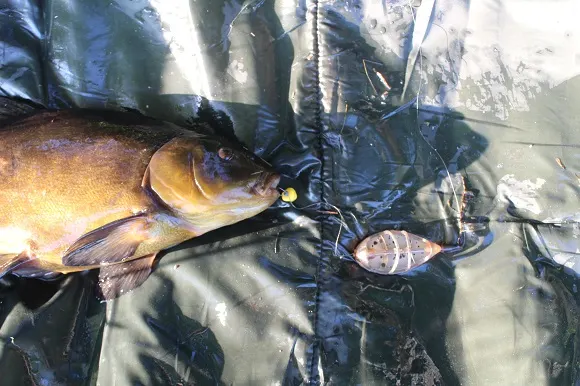
This is definitely my number one rig choice for big tench. It’s the perfect rig for fishing smaller boilies, pop-ups or a pair of fake corn, which I tend to use in venues that contain a lot of small fish that could steal my hookbait.
The inline feeder rig has several great features and together, they equal a superb bottom rig for tench.
No matter if you fish a lighter method feeder on the feeder rod or a heavy one on the specialist rod, this rig will almost always turn a careful biter into a hooked fish.
The method feeder’s two greatest advantages are the following:
- It allows you to chuck out a large amount of groundbait that’ll land right next to your hookbait (thanks to a very short hooklength). This makes for a high-precision bait presentation that is often absolutely essential when fishing for tench.
- Thanks to the very short hooklength, the fish almost always bolts itself against the weight of the method feeder. This increases the amount of landed fish rather drastically.
How to Rig and Fish the Method Feeder?
Remember: simple is often best! Here’s what you will need in order to rig your method feeder for tench
- a method feeder (20-30g for feeder rods, 40-50g for specialist rods) (find my favourite method feeder on Amazon here)
- an anti-tangle sleeve
- a 3-5 inch braided or fluorocarbon hooklength
- a #8-#12 wide gape hook
For boilies, pop-up and fake corn, which you’ll fish on the hair, you will also need a boilie stop. Such baits are best fished on a #8 wide gape hook. If you are fishing other baits directly on the hook, such as maggots, casters, or sweetcorn, I’d go for a #10-#12.
Now, all that’s left is the groundbait that goes directly onto your method feeder. You can either directly squeeze the groundbait on the feeder, or use a mould. The latter will give you a more even and well-shaped groundbait portion that some find easier to cast out.
And that’s it! Your method feeder is baited and ready for action! Just put on new groundbait whenever you recast and wait for that first tench bite!
Lift Method
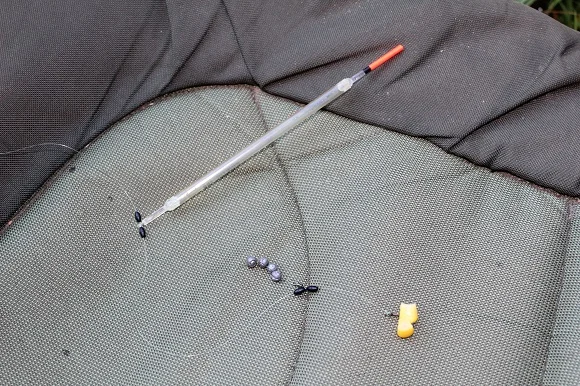
Perhaps the most common way of fishing for tench is by using a float or waggler. The lift method is a classic and proven technique that catches both smaller and really big tench.
Of course, this tench rig can only be fished at a closer distance and works best just off the margins, near vegetation such as weeds or reeds. The feeling you get when that waggler tip rises up and out of the water is indescribable!
And it’s such an easy way to fish for tench, which is a fact that makes this tench rig the perfect choice for beginners!
How to Rig and Fish the Lift Method?
Here is the end tackle you will be needing for the lift method:
- a 4-6BB crystal waggler (You can find brilliant tench wagglers on Amazon here)
- a micro swivel
- a few split shots and a 2 inch long piece of your mainline
- line stops to trap waggler and anchor weight with
- a #8-#14 wide gape hook
That is all you need for the lift method! I like to trap both my waggler float and my anchor weight between 2 line stops each, as they allow me to both set the depth very precisely and to lengthen or shorten the distance between hook and anchor weight.
The latter is often very helpful when the bites are difficult and I’m just not able to hook the tench after a lift bite. In such situations, I simply slide my anchor weight an inch or so further up the mainline. This results in a slightly longer hooklength and less resistance for the fish when they pick up the bait.
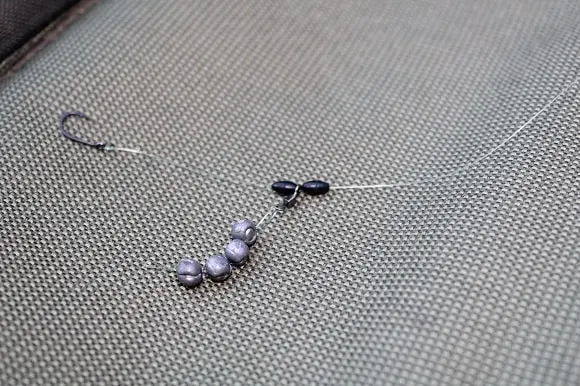
Rather than putting a split shot or two directly on the mainline, I prefer an anchor weight setup like this (remember: as little resistance as possible).
Simply create an open loop with the piece of mainline through the micro swivel and attach 3-4 SSG split shots to it (or just enough to sink your waggler float).
Now, you just have to find the right depth (your red float tip should stick out just a few millimetres or so) and start getting those lifts!
RELATED ARTICLE: Want to read up on how to float fish with a waggler? Then make sure to also check out this in-depth article on the lift method!
Maggot Feeder Rig
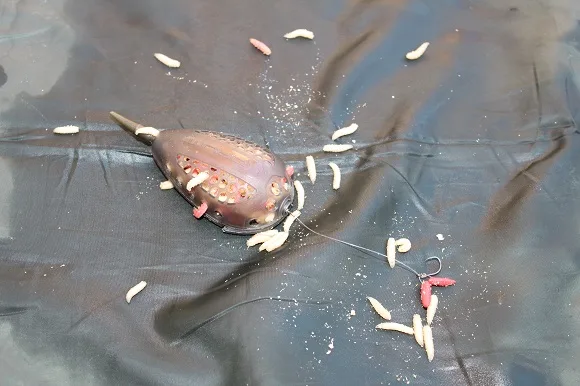
This is another classic tench rig that works great in waters that do not contain smaller silverfish. Even if maggots are comparatively small baits, tench simply love them and fishing the maggot feeder rig in your swim can result in a really awesome feeding frenzy with plenty of bites.
How to Rig and Fish the Maggot Feeder?
The maggot feeder can be fished both as an inline or blockend variant and both ways are extremely effective for tench.
Here is the end tackle you will need for the maggot feeder rig:
- a 20-30g maggot feeder
- a 2-3 inch fluorocarbon hooklength of 8-12lb, either just tied to a barrel swivel (inline feeder) or tied to a barrel swivel and trapped on the mainline with 2 line stops (blockend feeder)
- a #10-#14 wide gape hook
The inline maggot feeder is fished just as a conventional method feeder would be. The only difference is the feed, which does consist entirely of maggots, instead of groundbait. Check out my favourite inline maggot feeder on Amazon here.
You can either fish with live maggots directly on the hook, or with fake maggots or casters that you present on a small D- och hair rig. The thin fluorocarbon hooklength will allow you to do both.
The blockend maggot feeder is most commonly tied directly to the end of your mainline and is simply topped by a short hooklength that is fished helicopter-style around your mainline. Amazon offers a superb blockend maggot feeder.
Cage Feeder Rig
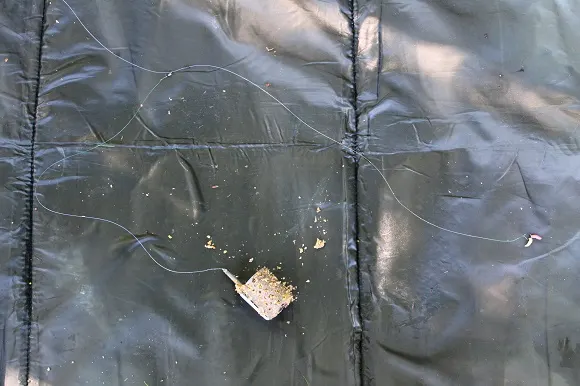
This is probably the simplest tench rig of them all and one that you must fish on the feeder- och quiver tip rod. In other words, when fishing the cage feeder rig, the fish that’ll bite will not bolt themselves!
Instead, you will have to rely solely on your eyes and the feeder tip to set the hook. But this is also this rig’s greatest strength because when the fish are slow and careful, actively fishing the cage feeder and being able to detect even the most careful of tugs will beat the less sensitive bolt and method feeder rig every time!
I have observed this fact many times on the bank. On those days, the bite alarms would only give off the occasional beep, but seldom was there an actual run that would follow. On the other hand, I would be able to land one fish after the other with my feeder rod.
How to Rig and Fish the Cage Feeder Rig?
For this rig, you really don’t need much tackle at all:
- a 20-30g open-end cage feeder
- a micro swivel
- 2 line stops
- a #8-#14 wide gape specimen hook
And that’s really all! You can use a lot of additional tackle here, like anti-tangle booms or tubes, but it’s really not necessary at all!
Mainly, what you’ll want to fish with is a rig that is able to carry out the groundbait and to give you a nice and clear bite indication. This rig will do that beautifully! Amazon has some really decent quality cage feeders that you can check out here.
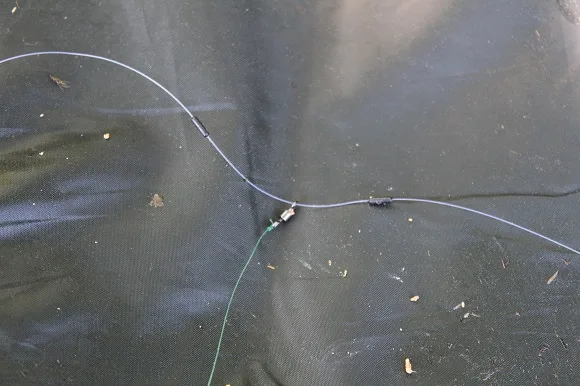
I prefer trapping the micro swivel with the feeder link with 2 small line or float stops, as it makes using a buffer bead and a mainline-hooklength connecting swivel obsolete. I want as few knots and possible weak points in my line as possible! Check out the super-tight line stops that I use for my tench fishing on Amazon here.
Another advantage of using line stops is that you can adjust the length between them. If the fish feed and bite confidently, I only give the feeder link a few inches to move up and down the mainline.
If, on the other hand, the bites are really careful and the fish extremely hard to hook, I will give the feeder link more room to move between. This often makes a really big difference, as the fish will feel even less resistance.
RELATED ARTICLE: Read this article to learn how to use and reuse float stops and what the very best and tightest stops on the market are.
Conventional Bolt Rig
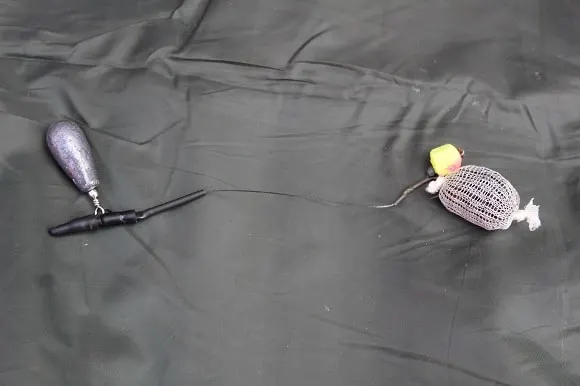
When fishing over a bed of particles, I often prefer the simple bolt rig. As I do not have to attach any groundbait to my rig, all that’s really needed is a conventional bottom rig that can present a smaller boilie or pop-up and manages to bolt the fish after it has taken the bait.
The bolt rig I am using for my tench fishing is really just a lighter version of a bolt rig for carp. It’s really easy to tie and extremely efficient!
RELATED ARTICLE: Make sure to also read this article on the best weather conditions for tench fishing!
How to Rig and Fish the Bolt Rig?
The bolt rig can be fished both with an inline lead or, as shown in the image above, with a safety clip. Both ways work really well for tench, as long as you keep your hooklength fairly short!
Here is the tackle you will need for a tench bolt rig setup:
- a conventional safety clip and cone for carp fishing
- a 1-1.5oz lead
- an anti-tangle sleeve
- a 3-5 inch braided or fluorocarbon hooklength
- a #8-#12 wide gape hook
- a piece of shrink tube for the hook shank for an even better hook angle (optional)
Once again, the size of your hook is determined by the type of hook bait you are using. For a pair of fake corn or smaller or scaled-down boilies and pop-ups, you can use a #8 wide gape hook.
For smaller hookbaits, such as fake maggots, casters or pellets, a #10-12 hook is your best choice.
Something I really want to stress here is the short hooklength. This is important for two main reasons:
- a shorter length prevents tangles when casting out
- short hooklengths often result in more hooked fish, as the tench bolt themselves at the slightest movement
Pro Tip: As you aren’t able to attach any loosefeed or groundbait to this rig, it can be a good idea to use smaller PVA nuggets filled with pellets or hempseeds. This will place a small and delicious portion of freebees right next to your hookbait! You can find top-quality PVA mesh on Amazon here.

